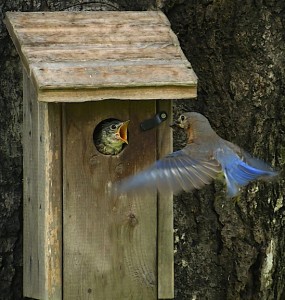Attracting bluebirds to your backyard
 The Eastern bluebird is a sign that spring has arrived. A member of the thrush family, the Eastern bluebird is commonly found throughout Alabama. Unlike other species of the thrush family, bluebirds regularly use cavities for nesting and readily take to man-made nest boxes.
The Eastern bluebird is a sign that spring has arrived. A member of the thrush family, the Eastern bluebird is commonly found throughout Alabama. Unlike other species of the thrush family, bluebirds regularly use cavities for nesting and readily take to man-made nest boxes.
The male bluebird is bright blue with a rust-colored breast and white sides and underparts. The female is a much paler blue than the male. Bluebirds inhabit both rural and urban areas, and open habitats such as gardens, parks, golf courses, orchards, roadsides and farms are preferred. Bluebirds are highly beneficial because they consume large quantities of insects such as grasshoppers, crickets, beetles and cutworms, all of which may be considered pests in certain situations.
Attracting bluebirds to your yard is quite easy, but there are a few things to consider. Offering food, water and nest boxes will increase the likelihood of attracting bluebirds to your area.
The first consideration is to determine if you have enough open area to support the bird’s diet of insects. Bluebirds are mainly insectivores, meaning they eat insects. In fact, 60 to 80 percent of their diet comes from insects. They also occasionally enjoy berries and suet from suet feeders, but do not frequent seed feeders.
If you want to view bluebirds up close and personal, you can feed live mealworms either from a feeder specially made for serving up mealworms or out of any container that will keep mealworms in one place. Live mealworms can be purchased from online birding sites or directly from a local pet store. You will find much enjoyment in watching bluebirds load up on as many mealworms as possible to feed their young. The many other species of birds that also eat insects will be attracted to the mealworm feeding site. They, too, will be common visitors and could become pests by consuming everything and keeping bluebirds from the feast.
Fruit and berry trees are also welcome additions to the bluebird’s habitat. Intersperse berry and fruit trees among open areas to provide additional forage opportunities. Dogwood, cedar, sumac and bayberry are some species to plant where appropriate.
The next step is to evaluate your area for nesting habitat. Bluebirds are cavity nesters and utilize natural tree cavities and abandoned woodpecker holes. Make an inventory of “snags” (dead trees) on your property; you may already have natural cavities on site and be pleasantly surprised as to what is living there. If you do not have natural cavities available, try putting up a nest box. Bluebirds readily take to man-made nest boxes. However, nest boxes need to be built according to specific dimensions. You can either build the bluebird box yourself (plans for building one are found on the Alabama Cooperative Extension website, www.aces.edu), or you can purchase one from a hardware store. Mount bluebird boxes on a fence post or pole roughly 4 to 5 feet from the ground. If placing your box along a woodland edge, situate the opening toward open land. If possible, keep your nest box as far away from human disturbance as possible.
Bluebirds will make hundreds of trips from where nesting material is found and back to their nest box. Providing nesting materials such as fine grasses, pine needles and dog hair, just to name a few, will further entice a pair of bluebirds into using your nest box. Place the collected nesting materials either in an empty suet feeder or gather small bunches of nesting materials and place in the bark and crevices of a tree trunk. Before you know it, bluebirds will be setting up home!
Finally, do not forget to offer plenty of water. During the hot summer months, fresh clean water can become a scarce commodity for backyard wildlife. Although bluebirds get moisture from insects, fruits and berries it is still a good idea to provide clean watering stations throughout your backyard.
If you plan and manage your property to meet the life requirements of bluebirds, then you will most likely have bluebirds as backyard neighbors.
For more information on bluebirds in Alabama, contact the Alabama Department of Conservation and Natural Resources Wildlife Section or visit the North American Bluebird Society’s website at www.nabluebirdsociety.org.
The Alabama Department of Conservation and Natural Resources promotes wise stewardship, management and enjoyment of Alabama’s natural resources through five divisions: Marine Police, Marine Resources, State Lands, State Parks, and Wildlife and Freshwater Fisheries. To learn more about ADCNR visit www.outdooralabama.com.
Ericha Nix is a Certified Wildlife Biologist for the Alabama Division of Wildlife and Freshwater Fisheries.
